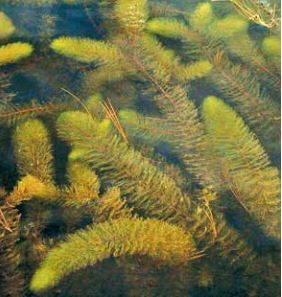What are invasive species?
Invasive species are non-native organisms that can cause harm to the local ecosystem, economy, or to human health.
What are the impacts of invasive species?
Invasive species can harm other plants, decrease wildlife habitat, decrease biodiversity, decrease available nutrients, increase erosion, and make the ecosystem more vulnerable.
“An ecosystem is a geographic area where plants, animals, and other organisms, as well as weather and landscapes, work together to form a bubble of life.” (National Geographic) When there is a change in the ecosystem, the area can become out of balance. Since invasive species are non-native, they can outcompete many other organisms, and reproduce fast. Each organism has a specific role in the ecosystem. When an invasive species takes over and harms the other organisms, the ecosystem functions provided by those organisms are lost. The area then becomes more vulnerable.
An example is Asiatic Bittersweet, an invasive vine commonly found in the Lake Auburn Watershed. Asiatic Bittersweet was introduced to the area because it’s red berries and glossy leaves are commonly used in ornamental wreaths. It grows by climbing onto other plants, wrapping around them, and growing upwards. In this process, the Asiatic Bittersweet harms the plants it grows on. Additionally, bittersweet grows fast, and the only way to remove it is to remove its thick roots that grow horizontally underground. The end result is large patches of bittersweet that are very hard to manage and can damage many of the organisms in the area.
Invasive species commonly found in the Lake Auburn Watershed
Terrestrial species:
Asiatic bittersweet
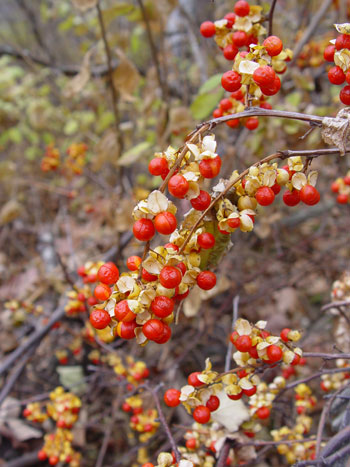 Asiatic bittersweet is a woody vine with bright red berries in the fall-winter. The leaves are green, simple and alternate, circular/elliptical shaped, 2-4 inches long, and have pointed ends. It has orange roots that travel horizontally underground. To remove bittersweet, uproot smaller vines, and cut thick vines at chest and ankle height.
Asiatic bittersweet is a woody vine with bright red berries in the fall-winter. The leaves are green, simple and alternate, circular/elliptical shaped, 2-4 inches long, and have pointed ends. It has orange roots that travel horizontally underground. To remove bittersweet, uproot smaller vines, and cut thick vines at chest and ankle height.
Autumn olive
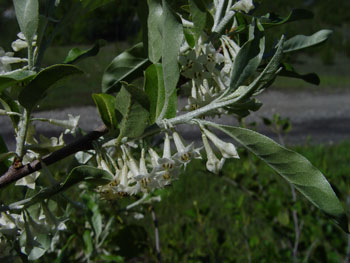 Autumn olive is a deciduous shrub with light brown and smooth branches, and fruit that looks like olives in the fall. The leaves are slim, simple and alternate, and 1-3 inches long. Each plant can get up to 15 feet tall. Smaller plants can be uprooted but larger plants must be persistently cut and maintain root damage (cutting, burning) for the plant to die.
Autumn olive is a deciduous shrub with light brown and smooth branches, and fruit that looks like olives in the fall. The leaves are slim, simple and alternate, and 1-3 inches long. Each plant can get up to 15 feet tall. Smaller plants can be uprooted but larger plants must be persistently cut and maintain root damage (cutting, burning) for the plant to die.
Japanese barberry
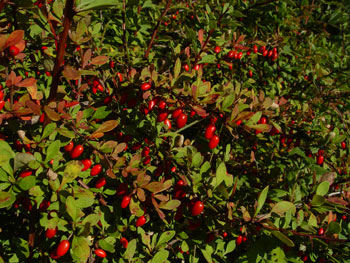 Japanese barberry is a deciduous shrub with lots of leaf covered branches, and long, red, hanging berries in the summer. The leaves are simple and alternate, up to 1 inch long, green in the summer, and red in the fall. Each plant can get up to 6 feet tall. Smaller plants can be uprooted but larger plants must be persistently cut and maintain root damage (cutting, burning) for the plant to die.
Japanese barberry is a deciduous shrub with lots of leaf covered branches, and long, red, hanging berries in the summer. The leaves are simple and alternate, up to 1 inch long, green in the summer, and red in the fall. Each plant can get up to 6 feet tall. Smaller plants can be uprooted but larger plants must be persistently cut and maintain root damage (cutting, burning) for the plant to die.
Japanese knotweed
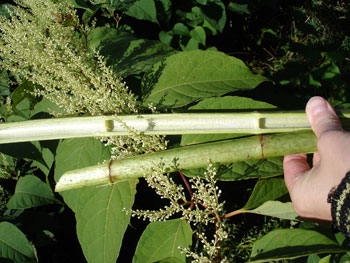 Japanese knotweed, also known as Mexican bamboo, is a herbaceous perennial, with green and reddish stems, resembling bamboo, that are hallow in the center. The leaves have a flat base, are simple and alternate, and up to 6 inches long. In the summer there are many small white flowers along the stems that stick upwards. Knotweed has rhizomes (underground horizontal roots) that sprout upwards, which can let knotweed spread very fast and densely. The plant can grow up to 10 feet tall. To manage knotweed, patches must be cut back and covered around once a week.
Japanese knotweed, also known as Mexican bamboo, is a herbaceous perennial, with green and reddish stems, resembling bamboo, that are hallow in the center. The leaves have a flat base, are simple and alternate, and up to 6 inches long. In the summer there are many small white flowers along the stems that stick upwards. Knotweed has rhizomes (underground horizontal roots) that sprout upwards, which can let knotweed spread very fast and densely. The plant can grow up to 10 feet tall. To manage knotweed, patches must be cut back and covered around once a week.
Aquatic:
Variable Milfoil
Variable water-milfoil is a very dense aquatic invasive plant that whose shape is commonly compared to a bottle brush. The feather like leaves are arranged in whorls, meaning that the leaves grow in a circular pattern around the stem. There are about 4-6 leaves on each whorl. Milfoil can grow in depths of 10-12 feet, and forms dense mats near the surface. This can prevent other aquatic plants to receive sunlight. Please reach out to LAWPC staff if you see any Milfoil on Lake Auburn, one of it’s tributaries, or on any boats entering Lake Auburn.
Resources
View the resources below for more information on invasive species, and for more information on invasive species management (removal and disposal):
Maine Department of Agriculture, Conservation, and Forestry
University of Maine Cooperative Extension

